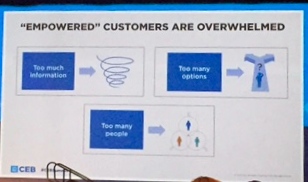by scott.gillum | Feb 28, 2016 | 2016, Marketing
 Having a hard time convincing “the powers that be” to invest in the brand? Ever wonder why it’s so hard, why all they want from marketing is leads? Let me explain.
Having a hard time convincing “the powers that be” to invest in the brand? Ever wonder why it’s so hard, why all they want from marketing is leads? Let me explain.
In organically grown companies, an organization develops a product or service and goes to market through a sale channel, either owned or via a partner. At this point, the organization is focused on acquiring customers and generating revenue. With low market awareness the organization typically has more sales capacity than demand for its products or services.
If marketing exists, it’s in its infancy, and plays a tactical role developing sales material, supporting business development activities, and it may have a small social media presence.
To fuel the company’s growth, the management team begins to realize in order to make sales and revenue objectives it has to be able to create demand beyond what the sales channels can generate on its own. As a result, marketing expands beyond its most basic sales enablement role into being responsible for generating leads.
When growth slows and/or begins to plateau, the executive management team will (or should) begin to explore the value of “strategic” marketing. Unfortunately, these strategic marketing activities and investments aimed at broadening awareness of the brand are often misunderstood and/or dismissed all together. Here’s why they shouldn’t be, and why they are critical to unlocking a company’s next phase of growth.
Why it’s so hard getting to “Yes”
The challenge in convincing the organization that marketing can be a strategic growth level is one of perception. Because marketing evolves “bottom up” as I just described, the common perception among executives is that marketing is a “tactical support” function.
The second issue is the messenger. The staffing needs of marketing in its infancy are simple, and usually satisfied by an entry-level hire or someone without a marketing background. Rarely, will this person rise to a senior management level. Achieving senior executive “gravitas” is critical for changing perception among the senior management team, especially if the company has a strong sales and/or product culture.
How to win the battle
To convince executives, you have to tie brand investments back to something “tangible.” Your argument has to show a direct connection to an organizations performance, be it sales, profit or the customer. And, if you can improve your message, you will also improve how your executives view the messenger. Here are three areas to explore.
- A strong/valued brand lifts price point. Are reps constantly complaining about being beaten up on regarding cost/price? A company that has a strong brand can command a price premium. Years ago, I did some work with competitor of Cisco and found that the Cisco brand had a price premium of 7% over the competitors. Why? B2B purchases are high risk, and as a result, are emotionally charged. Buyers that connect personally to brands are willing to pay more for their product if they believe it will reduce the risk of a bad decision. Need proof, click here.
- Improving top of the funnel performance improves the performance of the entire pipeline. Need to increase leads? You have two choices, expand the top of the funnel, or increase conversation rates. The best solution is to do both. By expanding the number of prospects aware of your product you increase the number who will also consider it, which increases the number of opportunities, leads and wins. If you only focus on increasing leads, you’re stuck with improving conversion rates, which may be much more difficult and/or costly.
- Brand building doesn’t mean you need a big budget. The fact is you’re doing it everyday, for better or worse. Every conversation a sales rep has with a prospect creates a brand impression, every unresolved service call to the contact center has the potential to damage the brand. You can make great strides by clearly and consistently communicating what the brand stands for both internally and externally. Once defined, put it into the language of your audience in the simplest terms possible. Complex, “consultant like” words and terms are meaningless. The really smart folks simplify the complex.
Now that you’ve made the argument, it’s time to close the deal. When an executive evaluates a proposal from your company against other competitors, do you know what tips the scale in your favor? No, it’s not price, or the “relationship,” it’s your reputation, your brand. It’s how they feel about your company…and that’s not in your proposal.
by scott.gillum | Jan 19, 2016 | 2016, Marketing
 Go ahead and get mad at me. Feel free to fill up the comment section below. I’m going to share our closely held secrets with sales people, skeptics and other critics of marketing. I know you would rather I not, but it’s best for all of us, trust me. Here we go…
Go ahead and get mad at me. Feel free to fill up the comment section below. I’m going to share our closely held secrets with sales people, skeptics and other critics of marketing. I know you would rather I not, but it’s best for all of us, trust me. Here we go…
#1 – You got lucky – if you generate leads off the first drop/wave of a new account acquisition or a lead generation campaign for a solution, you’re more likely to be lucky, than right. Yea, you may have had a compelling offer, and the call to action was intriguing, but the chances are, you just happened to hit a prospect at the right time.
Sure, in some industries you can buy data that identifies a company’s spend on certain products or services. But you don’t know if the budget is available, what portion of it, or who controls it. And since this is a prospect, you are most likely targeting a title, which could be a decision maker, a budget holder, or just a curious information seeker.
At the beginning of a campaign you simply don’t have the information on a prospect to know where they are, or how to advance them in the buying process. So, if a prospect does put their hand up and says, “Call me,” you most likely hit them at the right time in the buyers’ journey.
#2 – Your messaging is weak – the effectiveness of your message is being compromised by the fact that you are trying to motivate an audience to think or feel differently without explaining why. According to Pat Spenner, co-author of the new book entitled The Challenger Customer, marketers spend too much time focusing on how they want audiences to think, or feel, without understanding their current mindset.
Research for the book found that the receptiveness and/or openness to a message depends heavily on an audience’s existing belief system, which drives their behavior. According to Spenner, marketers first need to understand and break down the audience’s current mindset using insights about their business, customers, markets, etc. It’s an opportunity to “teach” audiences that their current thinking is no longer valid and why a new way of thinking is needed. If done well, the new mindset will uniquely lead them back to your product/services or brand.
For example, Merck developed the cholesterol-lowering drug Mevacor at a time when doctors knew little about the effects of cholesterol on the body. The current mindset was that hypertension (high blood pressure) caused heart disease. Merck used clinical research to show doctors the impact of high levels of cholesterol on arteries and the correlation of plaque buildup with coronary heart disease (the “teaching” moment).
As a result, doctors should test patient’s cholesterol levels to see if they are at risk. If a patient had a LDL cholesterol level above a certain point, doctors should start with a therapy regiment that included diet and drug treatment (the new mindset). The only cholesterol-lowering agent available at the time was, you guessed it, Mevacor. Merck, by getting doctors to change their mindset about the causes of heart disease, lead them back to their product. As Spenner puts it, effective story telling for marketers should “lead to, not with.”
#3 – You’re doing lead nurturing the wrong way – changing mindsets takes time. Yes, you’ve built prospect profiles, aligned content to their interest, and you may even know how to engage them in their preferred communication channel. The problem may not be your content marketing efforts but the fact that prospects are stuck in the status quo. They may find your information interesting, but it hasn’t convinced or motivated them to change their behavior.
Nurturing efforts should continue to break down, or build up, the new mindset across the buying group. The ability to drive specific information aligned to individual buyer’s needs may actually be causing more dysfunction within an already dysfunctional group. To advance a prospect/s refocus efforts on driving consensus on the issue and solution within the buying group. If done correctly, like Merck, prospects will come to own conclusions that you offer the best solution for their needs.
Motivating an audience to change doesn’t happen overnight. Unfortunately, marketers are under constant pressure to perform and rarely have the luxury of time to change their approach. It’s the reason I shared the first dirty secret, to buy marketers time to create the type of campaigns that deliver insights told as a story revealed over time.
The first wave of your campaign will generate leads, but it’s the waves that come after that really count. If marketers can stop telling customers why they need their product and let them come to that conclusion on their own, response and conversion rates will double based on my experience. But don’t tell anyone, it’s a secret.
by scott.gillum | Dec 7, 2015 | 2015, Business Trends, Uncategorized
 Gartner predicts that by 2018, machines will replace writers, authoring 20% of the content you read. Daryl Plummer, a Gartner analyst said that “Robowriters” are already producing budget, sports and business reports, and this trend is happening without notice. One advantage for machines according to Plummer: “They don’t have biases or emotional responses.”
Gartner predicts that by 2018, machines will replace writers, authoring 20% of the content you read. Daryl Plummer, a Gartner analyst said that “Robowriters” are already producing budget, sports and business reports, and this trend is happening without notice. One advantage for machines according to Plummer: “They don’t have biases or emotional responses.”
I’ll buy machine generated content for basic information, like the items mentioned above, and that may signal that it’s time for some writers, in particular those who create “formulaic” content (like press releases), to get their resumes together. But what I won’t buy is a world of content that exists purely on fact and data, void of any emotional connections. In fact, another trend is now happening that may signal a need for even more writers who can make personal connections with audiences.
“Design Thinking” to the Rescue
The good news is that companies, like IBM and GE are following Apple’s lead in embracing “Design Thinking.” This year alone, IBM is seeking to hire 1,100 designers to help reignite growth and change the corporate culture. What may be a “boom time” for designers may also have a waterfall effect on content creators, here’s why.
Companies are embracing design thinking as a response to the increased complexity of today’s products and/or business environment. As Apple has learned, people need their interactions with technologies and other systems (for example, Healthcare) to be simple, intuitive and perhaps, even enjoyable.
The first principle of design thinking for products is to empathize with users by focusing on their experiences, especially their emotional ones. To build empathy with users, a design-centric organization empowers employees to observe behavior and draw conclusions about people’s needs and wants.
As author Jon Kolko states in his Harvard Business Review article entitled Design Thinking Comes of Age, “organizations that “get” design use emotional language (words that concern desires, aspirations, engagement, and experience) to describe products and users.”
“Design thinking is an essential tool for simplifying and humanizing.”
As companies improve the product/user experience, organizations must improve how they communicate emotionally derived value propositions…and that is the opportunity for content marketers. “Robowriters” can’t understand the emotional triggers involved in the purchasing process — at least not yet. As CEO Tony Fadell said in an interview published in Inc., “At the end of the day you have to espouse a feeling—in your advertisements, in your products. And that feeling comes from your gut.”
With ever expanding distribution channels, the need for content has never been greater. As machines move in to fill the void, the world of content will divide into algorithm-assembled fact oriented content, and human generated “emotional” content.
The handwriting may on the wall for some writers but the upside of this trend may just usher in golden era of impactful relevant content marketing for many. For now, if you a create content take inventory of what you do on a daily basis, and make plans to move to the human side…or risk being replaced by a “Bot.”
by scott.gillum | Oct 29, 2015 | 2015, Sales
My first job out of college was selling office equipment. The first thing I ever learned about selling (from my very Southern sales manger) was that “Telling ain’t selling.” In layman terms, stop telling customers why they need your product and start listening to their needs.
For years this simple phase remained in my memory. It guided me as a way to engage prospects in advisory-like sales dialogue, probing for a need to sell to. But, after attending CEB’s Sales & Marketing Summit last week, where new research highlighted the increased complexity in reaching a purchase decision, I’m now considering rethinking my whole approach.
Why? Because buyers have become overwhelmed by the potential choices,  and the involvement of other decision makers in the process, according to Brent Adamson, co-author of The Challenger Customer. Too much information, too many options and too many people involved in the process are making it more difficult than ever to reach a consensus, let alone a purchase decision. Given the complexity, stalled deals are no longer a sales issue; they’re a buying problem.
and the involvement of other decision makers in the process, according to Brent Adamson, co-author of The Challenger Customer. Too much information, too many options and too many people involved in the process are making it more difficult than ever to reach a consensus, let alone a purchase decision. Given the complexity, stalled deals are no longer a sales issue; they’re a buying problem.
The question is: Are marketers contributing to that problem? Is it possible our content marketing efforts, aimed at helping buyers make an informed choice, are becoming part of the “too much” problem? According to Psychologist Barry Schwartz, author of The Paradox of Choice, too much choice often results in no choice at all.
Dr. Schwartz’s research has shown that limiting choice is often necessary to reach a decision, and/or to speed up the buying process. As he said, “When you make choice easier, or more simple, you will sell more.”
For business-to-business sales and marketers, the key is to become “prescriptive,” according to Adamson. Customers need a “trusted advisor” to help guide them through the complexity of the decision making process, in particular in driving a consistent point of view on the problem, and the best solution. Schwartz suggests focusing on the following three areas:
- Be the “expert” or “simplifier.” Help reduce the complexity of the problem, process and/or solution. Smart content should help to explain and simplify solutions to complex problems.
- Create an “anchor.” Help customers understand how to assess the value you offer. Buyers may have a hard time assessing the true value of a new purchase or a new vendor. Help them by giving them context. Find a relatable anchor comparison. Think: ”Platinum service at a standard price.”
- Understand the impact of “no decision.” If no decision is the right decision, then find a way to make it the default answer. This approach is commonly seen in software or subscription-based services where membership/licensing automatically renews.
Do we now dictate to customers/prospects? Not according to Schwartz. Asking probing questions that lead customers to convince themselves that they need your product is the path to goal attainment. Help them understand how your product/service uniquely solves their problem by guiding their path to purchase.
The words of wisdom given to me years ago were right, but given today’s increased complexity it needs an updated “Telling ain’t selling…until it is.”
by scott.gillum | Oct 5, 2015 | 2015, Marketing
 The Volkswagen scandal has already claimed the CEO. But could the damage also take down the company, or be the nail in the coffin for diesel automobiles in the US? Some are starting to think so: VW stock has fallen 30 percent since the scandal broke, and there are broader concerns about the impact on the reputation of Germany’s automobile industry. How could something that has the potential to be so damaging to an organization, and industry, happen?
The Volkswagen scandal has already claimed the CEO. But could the damage also take down the company, or be the nail in the coffin for diesel automobiles in the US? Some are starting to think so: VW stock has fallen 30 percent since the scandal broke, and there are broader concerns about the impact on the reputation of Germany’s automobile industry. How could something that has the potential to be so damaging to an organization, and industry, happen?
At some point, someone in the VW organization decided to cheat, and others within the organization approved that decision. And with that, it set in motion a chain of events that would reach across the organization. Someone designed the “defeat device” that could sense when the car was undergoing emission testing; another group tested the software to ensure it was working properly. Others submitted data to governing organizations using the deceptive and/or outright false data and so on (you get the picture, and it’s not pretty). VW’s corporate culture condoned this behavior.
“Big deal,” you say. “Things like this are probably going on in big global corporations all the time, all over the world. CEOs are out to win at any cost.” Not so fast. Research from the FORTUNE Knowledge Group and gyro found that sixty percent of executives prefer to do business with companies that are intent on doing what’s right, even when it doesn’t necessarily maximize revenue.
And don’t think that CEOs aren’t paying attention to a company’s reputation. When choosing a company to do business with, 70 percent of executives in the study cite company reputation as the most influential factor, with the company’s culture being the top driver of reputation, according to 53 percent of executives surveyed by FORTUNE and gyro.
Not only will VW take it on the chin from consumers – especially customers who own their diesel cars – but they are also going to feel the repercussion on the business side as well. Key decision makers, from suppliers to dealers, are going to be distancing themselves from the organization. This could potentially hurt the company’s ability to repair its reputation, which, according to a 2013 study by Deloitte, is the “number one strategic risk for large companies.”
The lesson: If you cheat, you will eventually get caught. Even though you may be able to avoid punishment (like a certain football player), you will not escape having your brand and reputation damaged. For some brands, that could represent up to two-thirds of the company’s value.
When an organization deceives us, they betray our trust and it’s deeply personal. It doesn’t matter if it’s a friend or a car manufacturer, our brains trust brands the same way we trust our friends, according to research from the Institute for Experimental Business Psychology at Leuphana University in Luneburg, Germany (of all places).
 Having a hard time convincing “the powers that be” to invest in the brand? Ever wonder why it’s so hard, why all they want from marketing is leads? Let me explain.
Having a hard time convincing “the powers that be” to invest in the brand? Ever wonder why it’s so hard, why all they want from marketing is leads? Let me explain.


 and the involvement of other decision makers in the process, according to
and the involvement of other decision makers in the process, according to 





